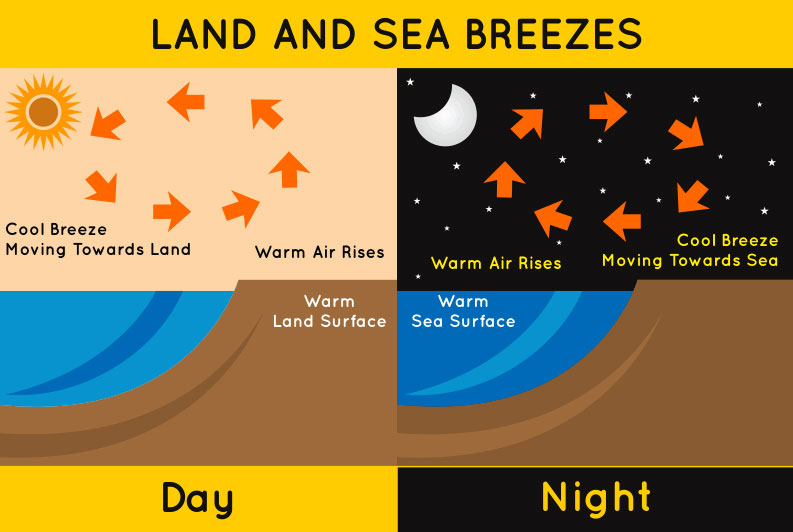Sun heats both land and water but they get heated differently due to their differential heat retention capacity. This differential heating and cooling of land and sea give rise to gentle to a moderate wind which is termed as a breeze. Depending on the direction of its flow, the breeze is classified into two categories – Land Breeze and Sea Breeze.
What is Land Breeze?
The land gets heated faster than the sea and it also gets cooled rapidly. So, after the sun sets, the land releases heat much faster than the sea and creates an area of high pressure above it. Similarly, a comparatively low-pressure area is created over the sea. As a normal phenomenon air from the high-pressure area (land) rushes towards the low-pressure area (sea) creating a breeze that is termed as a land breeze.
At night, the land loses heat quickly whereas water retains the heat for longer, this is the reason why the land breeze blow at night.
What is Sea Breeze?
When the sun is up, the land gets heated much faster than the sea. Thus, the temperature of the air above land increases and an area of low pressure is created above the land surface. The air above the sea, on other hand, creates a comparatively high-pressure zone. Air from the high-pressure zone (sea) rushes towards the low-pressure zone (land) creating a sea breeze.
Due to its property of getting heated slowly, the sea is much cooler than the land during the day time and this is the reason why the sea breeze blows during the day.
Illustration Diagram of Land and Sea Breeze

Differences between Land Breeze and Sea Breeze
| # | Land Breeze | Sea Breeze |
|---|---|---|
| 1 | Land breeze blows from the land towards the sea. | Sea breeze blows from the sea towards the land. |
| 2 | The land breeze blows during the night. | The sea breeze blows during the daytime. |
| 3 | A land breeze is comparatively shallower. | A sea breeze is deep as compared to the land breeze. |
| 4 | The air of the land breeze is dry. | The air of the sea breeze contains a good amount of moisture. |
| 5 | A land breeze is more prominent in winter and autumn due to cooler nights. | A sea breeze is more common during the summer season and the spring season. |
| 6 | A land breeze is slower in speed. It can normally go up to 8 knots. | A sea breeze is faster in pace and can go up to 20 knots. |
| 7 | Land breeze has no significant impact on the temperature of the surrounding area. | Sea breeze tends to make the temperature cooler. |
Impact of Land Breeze and Sea Breeze on the climate of the surrounding areas
The micro-climate of the coastal areas is greatly affected by the land breeze and sea breeze. Here are some of the important impacts of sea and land breeze:
- The air of coastal areas carries much more humidity than the inland areas due to the moisture-laden sea breeze.
- The sea breeze and land breeze prevents the extreme temperature in coastal areas.
- The coastal and offshore area experiences frequent precipitation due to the phenomenon of sea breeze and land breeze.
- The sea breeze and land breeze also prevent the accumulation of atmospheric pollutants in the surrounding areas.
Use the citation below to add this article to your bibliography
"Land Breeze and Sea Breeze: Definitions, Differences and Diagrams." Dashamlav.com. Web. 13 June 2025. <https://dashamlav.com/land-breeze-and-sea-breeze-definitions-differences-and-diagrams/>
Dashamlav.com, "Land Breeze and Sea Breeze: Definitions, Differences and Diagrams." Accessed 13 June 2025. https://dashamlav.com/land-breeze-and-sea-breeze-definitions-differences-and-diagrams/
"Land Breeze and Sea Breeze: Definitions, Differences and Diagrams." (n.d.). Dashamlav.com. Retrieved 13 June 2025 from https://dashamlav.com/land-breeze-and-sea-breeze-definitions-differences-and-diagrams/
